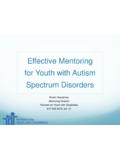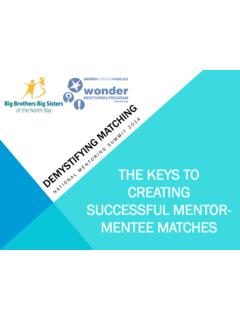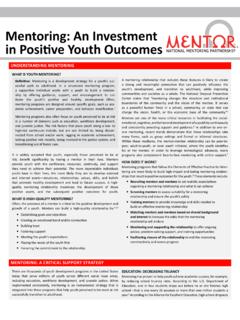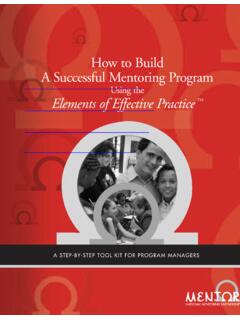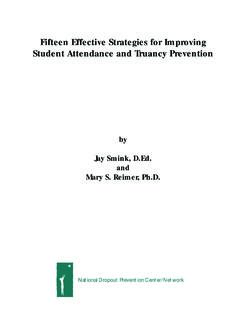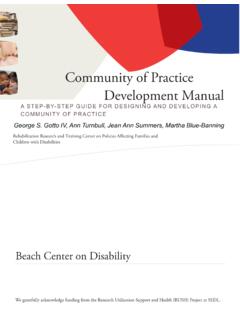Transcription of WORKPLACE MENTORING
1 WORKPLACE MENTORINGSUPPLEMENT TO THEELEMENTS OF effective PRACTICE FOR MENTORING October 20192 WORKPLACE MENTORING SUPPLEMENTTABLE OF CONTENTSI ntroduction and the World of WORKPLACE MENTORING ..3 Standard 1: Recruitment ..20 Standard 2: Screening ..40 Standard 3: Training ..52 Standard 4: Matching and Initiation ..70 Standard 5: Monitoring and Support ..82 Standard 6: Closure ..91 Program Planning, Management, and Evaluation ..103 AUTHORS AND CONTRIBUTORS:Dr. Janis Kupersmidt; innovation Research & Training, Dr. Rebecca Stelter; innovation Research & TrainingMichael Garringer; MENTOR: The National MENTORING Partnership, Justin Mayhew; innovation Research & TrainingACKNOWLEDGEMENTS:MENTOR and iRT would like to thank the following institutions and organizations for their support of this resource: - JPMorgan Chase for their generous support of this resource and for the high-quality MENTORING relationships offered through The Fellowship Initiative, which serves as an exemplar of WORKPLACE MENTORING for young people and was an initial inspiration for this project.
2 - The members of the working group of expert practitioners and researchers who helped shape the recommendations found in these pages (see page 14 for more information about this group). - Thanks to Erin Souza-Rezendes and Janicanne Shane for their editing at Special thanks to Cecilia Molinari and Jenni Geiser for their support in copyediting and graphic design, respectively. SPONSORED BY:3 WORKPLACE MENTORING SUPPLEMENTOne of the dominant trends of the youth MENTORING movement over the last decade is the proliferation of MENTORING roles into settings that go far beyond either dedicated MENTORING programs ( , Big Brothers Big Sisters) or typical youth development contexts ( , after-school programs). A 2015 survey of organizations that provide youth MENTORING services found that the vast majority of them also run some other service or intervention for youth or While it is unclear how frequently the MENTORING program within these organizations supported the other services and interventions, one can assume that in many of these organizations, dedicated MENTORING was provided in conjunction with other services and supports, bringing mentors to everything from clinical mental health interventions to college and career preparatory services.
3 In fact, this same survey found that 26 percent of the agencies that run MENTORING programs also offer separate workforce development and job training services. And when asked specifically about their goals and areas of emphasis for youth who receive MENTORING , a quarter of MENTORING programs indicated that they focus on career exploration, with an additional 6 percent focusing specifically on Science, Technology, Engineering, and Math (STEM) education and career pathways. Broadly speaking, career exploration and engagement is the third most common goal across MENTORING programs in the United application of MENTORING relationships in service of career goals, especially for new or entry-level workers, is nothing new. In fact, we can trace the value of deep learning relationships with more experienced adult professionals back to the guild and apprentice structures that emerged literally several centuries ago.
4 In more recent times, it has become fashionable for companies to offer internal MENTORING opportunities to their adult employees as a way of encouraging employee retention, sharing institutional knowledge, and supporting the advancement of lower-level workers into supervisory positions and management over time. But several recent trends have also converged to ignite renewed interest in using mentors to support older adolescents and young adults as they enter the world of work: o A growing emphasis on equity within certain fields. There has been major investment in STEM MENTORING programs for youth in an effort to bring more women, minorities, and people with disabilities into STEM careers where they are severely underrepresented. In fact, see our companion publication, the STEM Supplement to the elements of effective Practice for MENTORING , to read about how leading tech companies such as Genentech and 3M, and programs like Girls Inc.
5 And Science Club, are using MENTORING to address systemic inequities in those For a great example of a program that is working to make the world of work (both STEM and otherwise) more accessible for youth with disabilities, see the description of the Disability:IN program later in this chapter. INTRODUCTION AND THE WORLD OF WORKPLACE MENTORING4 WORKPLACE MENTORING SUPPLEMENTo A general desire to strengthen talent pipelines. Many American industries ( , manufacturing4 and the aforementioned STEM fields5) are suffering from a shortage of qualified workers of all types and MENTORING can be a way to initially interest youth in pursuing particular careers, as well as keeping them on that pathway as they overcome hurdles and build their sense of belonging within an industry. o Efforts to integrate opportunity youth into the labor market.
6 Much has been made in recent years about so-called opportunity youth, young people ages 16 24 who are not working, enrolled in school, or engaged in other prosocial activities and institutions. The services provided to these young people require taxpayer investment, and they are not contributing to the economy more To the nation s credit, there has been much effort over the last decade to reengage this population. Relationships with adults are often at the heart of efforts to get opportunity youth back into the worlds of education and trends, along with recognition that it is harder today for young workers to find entry-level jobs and slowly build a resume and relevant job experience than in prior generations, have led to an explosion in the number of youth MENTORING programs that are explicitly helping youth explore careers.
7 Today we find a diverse landscape of career and WORKPLACE MENTORING options for youth, one that covers everything from MENTORING programs for middle schoolers to introduce them to careers they may never have considered, to hybrid job shadow/ MENTORING programs that bring young adults into worksites to build both hard and soft skills that will benefit them for the long haul (and perhaps even land them a job in the short term with that company). What are the practices that make these MENTORING programs effective ? What are the day-to-day practices that these types of programs employ that differ from more traditional developmental MENTORING programs? While there are some INTRODUCTION AND THE WORLD OF WORKPLACE MENTORINGD efining WORKPLACE MENTORING for YouthWhile there are many ways that mentors can support youth of all ages as they learn about, explore, and engage in career pathways, this guide s recommendations will be most applicable to programs: Serving older adolescents and young adults (16 24).
8 Connecting employees of a business or a particular industry to serve as mentors to youth who are considering a career in that industry or related field. Bringing, at least occasionally, mentees to job sites and WORKPLACE environments for hands-on learning and shadowing. Offering both job-related skill development and socioemotional support to ease the transition into the role of a these actions may not describe many MENTORING programs focused on career interests, they do represent the most common features of programs we observed utilizing MENTORING to support career interests and placements for youth and young MENTORING SUPPLEMENT similarities of good practice across all youth MENTORING programs, these workforce-focused programs often have complex partnerships between nonprofits, schools, local employers, and other entities, as well as different expectations for mentors and the youth themselves.
9 So what makes this new generation of WORKPLACE MENTORING programs tick? Answering these questions is the purpose of this guide, as we examine the practices of successful WORKPLACE MENTORING programs for youth and offer specific recommendations for running such a program beyond those found in the overall elements of effective Practice for MENTORING . Throughout the rest of this resource you can find recommendations and case studies that can help similar programs prepare the mentors who will in turn prepare youth for the world of WORLD OF WORKFORCE-FOCUSED MENTORING PROGRAMSTo better understand the landscape of WORKPLACE MENTORING programs for youth, the team of authors behind this resource conducted a literature search for scholarly articles, evaluation reports, training curricula, and other materials relevant to MENTORING programs with a career exploration or job skills component.
10 We utilized prominent databases primarily Scopus, PubMed, Google Scholar, and ERIC then expanded to include additional articles suggested in the references of documents found in the initial search. When possible, relevant chapters from books and essay collections were also included. In all, we reviewed 198 separate articles, books, book chapters, reports, and other programmatic materials in developing this supplement. The following table offers a breakdown of these resources: While we did draw some themes and recommendations from the literature on adult-adult MENTORING in the WORKPLACE , we emphasized the findings of programs focused on adolescents or young adults just entering the workforce. When looking at those programs, the vast majority described either brought professionals in a particular industry or field to a school or nonprofit service provider s facilities in order to mentor youth and discuss careers and skills related to their industry or, more often, brought youth to worksites for hands-on learning, skill building, and MENTORING within the direct context of work.

